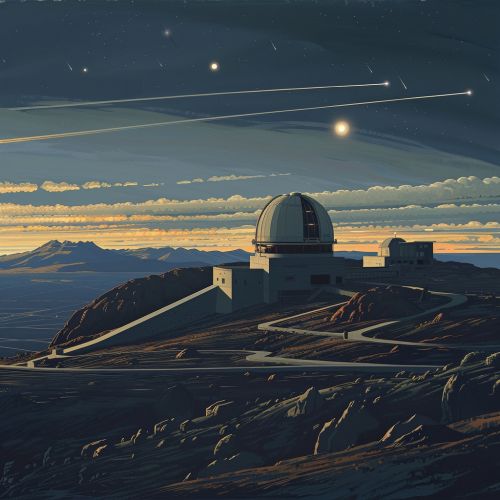Spaceguard
Overview
The Spaceguard is a term used to refer to various international organizations and their associated efforts to discover, track, and characterize near-Earth objects (NEOs) that pose a potential threat to Earth due to their orbits bringing them into close proximity with our planet. These objects, primarily asteroids and comets, can cause significant damage if they collide with Earth, and the goal of Spaceguard is to prevent such a catastrophe.


History
The concept of Spaceguard was first proposed in Arthur C. Clarke's 1973 science fiction novel Rendezvous with Rama, where it was depicted as an early warning system against extraterrestrial threats. The idea was later adopted by the scientific community and has since become a global initiative involving multiple countries and organizations.
Initiatives
There are several initiatives under the Spaceguard umbrella, each with its own specific focus and goals. These include:
- NASA Near-Earth Object Observations Program: This program is dedicated to finding, tracking, and characterizing NEOs. It funds several observatories and research projects, and provides the majority of NEO data to the international scientific community.
- ESA Space Situational Awareness Programme: This European initiative focuses on the detection, prediction, and mitigation of space weather phenomena, as well as the tracking of NEOs.
- International Astronomical Union's Minor Planet Center: The MPC is the global data center for asteroid and comet observations. It collects and verifies all NEO observations and provides this data to the scientific community and the public.
- Spaceguard Foundation: An Italian non-profit organization that coordinates research and public outreach activities related to NEOs. It also operates the Telescopio Nazionale Galileo, one of the largest telescopes in Europe.
Detection and Tracking
The detection and tracking of NEOs is a complex process that involves a combination of ground-based and space-based observatories. These observatories use powerful telescopes and advanced software to scan the skies for new objects, track their orbits, and determine whether they pose a threat to Earth.
Risk Assessment
Once an NEO has been detected and tracked, the next step is to assess the risk it poses to Earth. This involves calculating the object's orbit to determine its path and the likelihood of it intersecting with Earth's orbit. The size and composition of the object are also taken into account, as these factors can influence the potential damage it could cause in the event of a collision.
Mitigation Strategies
In the event that an NEO is found to pose a significant threat to Earth, various mitigation strategies can be employed. These can range from deflection efforts, such as using a spacecraft to alter the object's orbit, to destruction methods, such as nuclear detonation. The choice of strategy would depend on a variety of factors, including the size and composition of the NEO, its orbit, and the amount of warning time available.
Future Prospects
The field of NEO detection and mitigation is constantly evolving, with new technologies and strategies being developed to improve our ability to protect Earth from potential threats. Future prospects include the development of more advanced detection systems, improved risk assessment models, and more effective mitigation strategies.
